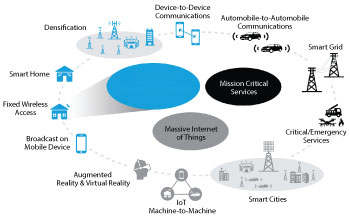FWA DEPLOYMENT
A clear advantage of using mmWave is the availability of underutilized contiguous spectrum at low cost. These bands allow wide component carrier bandwidths up to 400 MHz and commercial BTSs are being designed with carrier aggregation supporting up to 1.2 GHz of instantaneous bandwidth. Customer premise equipment (CPE) will support peak rates over 2 Gbps and come in several form factors: all outdoor, split-mount and all indoor desktop and dongle-type units. Mobile-handset form factors will follow.

Figure 2 Global 5G bands above 24 GHz.

Figure 3 End–to–end FWA network.
Global mmWave spectrum availability is shown in Figure 2. In the U.S., most trials are in the old block A LMDS band between 27.5 and 28.35 GHz, but the plan-of-record of carriers is to deploy nationwide in the wider 39 GHz band, which is licensed on a larger economic area basis. These candidate bands have been assigned by 3GPP and, except for 28 GHz, are being harmonized globally by the International Telecommunications Union.2
FWA describes a wireless connection between a centralized sectorized BTS and numerous fixed or nomadic users (see Figure 3). Systems are being designed to leverage existing tower sites and support a low-cost, self-install CPE build-out. Both are critical to keeping initial deployment investment low while the business case for FWA is validated. Early deployments will be mostly outdoor-to-outdoor and use professional roof-level installations that maximize range, ensure initial customer satisfaction and allow time for BTS and CPE equipment to reach the needed cost and performance targets.

Figure 4 FWA in a suburban environment.

Large coverage is essential to the success of the FWA business case. To illustrate this, consider a suburban deployment with 800 homes/km2, as shown in Figure 4. For BTS inter-site distance (ISD) of 500 m, we need at least 20 sectors, each covering 35 houses from nine cell sites. Assuming 33 percent of the customers sign up for 1 Gbps service and a 5x network oversubscription ratio, an average aggregate BTS capacity of 3 Gbps/sector is needed. This capacity is achieved with a 400 MHz bandwidth, assuming an average spectral efficiency of 2 bps/Hz and four layers of spatial multiplexing. If customers pay $100 per month, the annual revenue will be $280,000/km2/year. Of course, without accounting for recurring costs, it is not clear FWA is a good business, but we can conclude that as ISD increases, the business case improves. To that end, carriers are driving equipment vendors to build BTS and CPE equipment that operate up to regulatory limits to maximize coverage and profitability.
In the U.S., the Federal Communications Commission has defined very high effective isotropic radiated power (EIRP) limits for the 28 and 39 GHz bands,3 shown in Table 1. The challenge becomes building systems that meet these targets within the cost, size, weight and power budgets expected by carriers. Selecting the proper front-end architecture and RF semiconductor technology are key to getting there.

